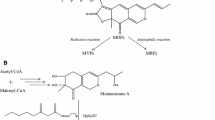Abstract
Filamentous fungi Monascus sp. has been utilized for fermentative production of food colorant (Red Yeast Rice) for more than 1000 years in China. The main colorant components of Red Yeast Rice are mixture of red Monascus pigments (RMPs) with various primary amine residues. In the present work, the non-natural primary amine p-aminobenzamide, exhibiting as non-involved in nitrogen microbial metabolism, nontoxicity to microbial cells, and chemical reactivity with orange Monascus pigments (OMPs), was screened. Based on the screened result, RMPs with the single p-aminobenzamide residue were produced by cell suspension culture in a nonionic surfactant micelle aqueous solution via in situ chemical modification of OMPs. Furthermore, in situ chemical modification of OMPs also provided a strategy for maintaining a relatively low OMP concentration and then efficient accumulation of high concentration of RMPs (3.3 g/l).






Similar content being viewed by others
References
Achard M, Beeler AB Jr, Porco JA (2012) Synthesis of azaphilone-based chemical libraries. ACS Comb Sci 14:236–244
Berezin IV, Martinek K, Yatsimirskii AK (1973) Physicochemical foundations of micellar catalysis. Russ Chem Rev 42:787–802
Bruggink A, Schoevaart R, Kieboom T (2003) Concepts of nature in organic synthesis: cascade catalysis and multistep conversions in concert. Org Proc Res Develop 7:622–640
Chen F (2018) Connection of researches of Monascus and Hongqu with industry. Proceedings for Monascus spp. and Their Relative Products in 2018. Wuhan China p. 120–122
Chen W, Chen R, Liu Q, He Y, He K, Ding X, Kang L, Guo X, Xie N, Zhou Y, Lu Y, Cox RJ, Molnar I, Li M, Shao Y, Chen F (2017) Orange, red, yellow: biosynthesis of azaphilone pigments in Monascus fungi. Chem Sci 8:4917–4925
Dufosse L, Fouillaud M, Caro Y, Mapari SAS, Sutthiwong N (2014) Filamentous fungi are large-scale producers of pigments and colorants for the food industry. Curr Opin Biotechnol 26:56–61
Dwars T, Paetzold E, Oehme G (2005) Reactions in micellar systems. Angew Chem Int Ed 44:7174–7199
Hajjaj H, Klaebe A, Loret MO, Tzedakis T, Goma G, Blanc PJ (1997) Production and identification of N-glucosylrubropunctamine and N-glucosylmonascorbramine from Monascus ruber and occurrence of electron donor-acceptor complex in these red pigments. Appl Environ Microbiol 63:2671–2678
Holmberg K (2007) Organic reactions in microemulsion. Eur J Org Chem 5:731–742
Hu Z, Zhang X, Wu Z, Qi H, Wang Z (2012) Perstraction of intracellular pigments by submerged cultivation of Monascus in nonionic surfactant micelle aqueous solution. Appl Microbiol Biotechnol 94:81–89
Hu M, Zhang X, Wang Z (2016) Releasing intracellular product to prepare whole cell biocatalyst for biosynthesis of Monascus pigments in water-edible oil two-phase system. Bioproc Biosyst Eng 39:1785–1791
Jung H, Kim C, Kim K, Shin CS (2003) Color characteristics of Monascus pigments derived by fermentation with various amino acids. J Agric Food Chem 51:1302–1306
Jung H, Kim C, Shin CS (2005) Enhanced photostability of Monascus pigments derived with various amino acids via fermentation. J Agric Food Chem 53:7108–7114
Lin T, Yakushijin K, Buchi GH, Demain AL (1992) Formation of water-soluble Monascus red pigments by biological and semi-synthetic processes. J Ind Microbiol 9:173–179
Lu F, Liu L, Huang Y, Zhang X, Wang Z (2018) Production of Monascus pigments as extracellular crystals by cell suspension culture. Appl Microbiol Biotechnol 102:677–687
Lv J, Qian G, Chen L, Liu H, Xu H, Xu G, Zhang B, Zhang C (2018) Efficient biosynthesis of natural yellow pigments by Monascus purpureus in a novel integrated fermentation system. J Agric Food Chem 66:918–925
Ma J, Li Y, Ye Q, Li J, Hua Y, Ju D, Zhang D, Cooper R, Chang M (2000) Constituents of red yeast rice, a traditional Chinese food and medicine. J Agric Food Chem 48:5220–5225
Mapari SS, Thrane U, Meyer AS, Frisvad JC (2012) Production of Monascus-like pigment. EU Patent WO2012/022765 A1
Miller GL (1959) Use of dinitrosalicylic acid reagent for determination of reducing sugar. Anal Chem 31(3):426–428
Sorella GL, Strukul G, Scarso A (2015) Recent advances in catalysis in micellar media. Green Chem 17:644–683
Vendruscolo F, Tosin I, Gigchini AJ, Schmidell W, Minow JL (2014) Antimicrobial activity of Monascus pigments produced in submerged fermentation. J Food Process Preserv 38:1860–1865
Wallace S, Balskus EP (2016) Designer micelles accelerate flux through engineered metabolism in E. coli and support biocompatible chemistry. Angew Chem Int Ed 55:6023–6027
Wang Z, Dai Z (2010) Extractive microbial fermentation in cloud point system. Enzyme Microb Tech 46:407–418
Wang B, Zhang X, Wu Z, Wang Z (2015) Investigation of relationship between lipid and Monascus pigment accumulation by extractive fermentation. J Biotechnol 212:167–173
Wei M, Wang C, Wang K, Qian P, Wang C, Shao C (2017) Preparation, structure, and potent antifouling activity of sclerotioramine derivatives. Mar Biotechnol 19:372–378
Winter G, Averesch NJH, Nunez-Bernal D, Krömer JO (2014) In vivo instability of chorismate causes substrate loss during fermentative production of aromatics. Yeast 31:333–341
Wong HC, Koehler PE (1983) Production of water-soluble Monascus pigments. J Food Sci 48(4):1200–1203
Xiong X, Zhang X, Wu Z, Wang Z (2015) Coupled aminophilic reaction and directed metabolic channeling to red Monascus pigments by extractive fermentation in nonionic surfactant micelle aqueous solution. Process Biochem 50:180–187
Zabala AO, Xu W, Chooi YH, Tang Y (2012) Characterization of a silent azaphilone gene cluster from Aspergillus niger ATCC 1015 reveals a hydroxylation-mediated pyran-ring formation. Chem Biol 19:1049–1059
Acknowledgements
This work was partially supported by Open Funding Project of the State Key Laboratory of Bioreactor Engineering.
Author information
Authors and Affiliations
Corresponding author
Ethics declarations
Conflict of interest
The authors declare no conflict of interest.
Additional information
Publisher’s Note
Springer Nature remains neutral with regard to jurisdictional claims in published maps and institutional affiliations.
Electronic supplementary material
Below is the link to the electronic supplementary material.
Rights and permissions
About this article
Cite this article
Huang, Y., Liu, L., Zheng, G. et al. Efficient production of red Monascus pigments with single non-natural amine residue by in situ chemical modification. World J Microbiol Biotechnol 35, 13 (2019). https://doi.org/10.1007/s11274-018-2585-6
Received:
Accepted:
Published:
DOI: https://doi.org/10.1007/s11274-018-2585-6




